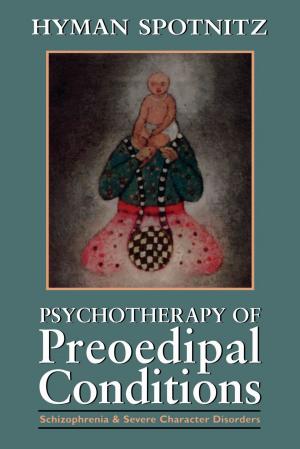The Primitive Edge of Experience
Nonfiction, Health & Well Being, Psychology, Psychoanalysis, Psychotherapy| Author: | Thomas H. Ogden | ISBN: | 9780765707383 |
| Publisher: | Jason Aronson, Inc. | Publication: | December 1, 1992 |
| Imprint: | Jason Aronson, Inc. | Language: | English |
| Author: | Thomas H. Ogden |
| ISBN: | 9780765707383 |
| Publisher: | Jason Aronson, Inc. |
| Publication: | December 1, 1992 |
| Imprint: | Jason Aronson, Inc. |
| Language: | English |
'This is an extraordinary and exciting book, the work of a truly original and creative psychoanalytic theoretician and most astute clinician. Ogden continues to expand and to deepen his reformulations of the British object-relations theorists, M. Klein, W. R. Bion, D. W. Winnicott, W. R. D. Fairbairn, H. Guntrip, to illuminate further the world of internalized object relations. His concepts are evolutionary and at times revolutionary. Exploring the area of human experience that lies beyond the psychological territories addressed by the previous theorists, he introduces the concept of an autistic-contiguous mode as a way of conceiving of the most primitive psychological organization through which the sensory 'floor' of the experience of self is generated. He conceives of this mode as a sensory-dominated, presymbolic area of experience in which the most primitive form of meaning is generated on the basis of organization of sensory impressions, particularly at the skin surface. A major tenet in the book is a conceptualization of human experience throughout life as the product of a dialectical interplay among three modes of generating experience: the depressive, the paranoid-schizoid, and the autistic-contiguous. Each mode creates, preserves, and negates the other. No single mode of generating experience exists independently of the others. Psychopathology is conceptualized as a 'collapse' of the dialectic in the direction of one or another mode of generating experience. The outcome of such collapse may be entrapment in rigid, asymbolic patterns of sensation (collapse in the direction of the autistic-contiguous mode), or imprisonment in a world of omnipotent internal objects where thoughts and feelings are experienced as things and forces which occupy or bombard the self (collapse in the direction of paranoid-schizoid mode) or isolation of the self from lived experience and aliveness of bodily, sensations (collapse in the direction of the depressive mode). Ogden presents his unique development of the autistic-contiguous mode as the synthesis, interpretation, and extension of the works of D. Meltzer, E. Bick, and F. Tustin. He is careful to state that this psychological organization is a developing and ongoing) mode of generating experience and not a limited phase of development; an elaboration of this primitive organization is an integral part of normal development. All three modes are considered not 'positions' to be passed through, outgrown, or overcome, and relegated to the past, but as integral dimensions of present adult ego functioning. Sensory experience in an autistic-contiguous mode has rhythmicity that is becoming the continuity of being; it has boundedness that is the beginning of experience of the place where one feels things and lives; it has features such as shape, hardness, cold, warmth and texture, beginnings of the qualities of who one is. As his generous case examples aptly demonstrate, Ogden's theories are solidly grounded in his discerning work with a broad variety of patients. His brilliant pathfinding will enlighten and enrich the reader with invaluable insights. He will listen with new ears and with a fresh conceptual framework with which to comprehend the most primitive elements of human development and the complex interplay among the different modes of experience. This is a bold, important, instructive, and stimulating book of equally great clinical and theoretical applicability.' —The Journal of the American Psychoanalytic Association A Jason Aronson Book
'This is an extraordinary and exciting book, the work of a truly original and creative psychoanalytic theoretician and most astute clinician. Ogden continues to expand and to deepen his reformulations of the British object-relations theorists, M. Klein, W. R. Bion, D. W. Winnicott, W. R. D. Fairbairn, H. Guntrip, to illuminate further the world of internalized object relations. His concepts are evolutionary and at times revolutionary. Exploring the area of human experience that lies beyond the psychological territories addressed by the previous theorists, he introduces the concept of an autistic-contiguous mode as a way of conceiving of the most primitive psychological organization through which the sensory 'floor' of the experience of self is generated. He conceives of this mode as a sensory-dominated, presymbolic area of experience in which the most primitive form of meaning is generated on the basis of organization of sensory impressions, particularly at the skin surface. A major tenet in the book is a conceptualization of human experience throughout life as the product of a dialectical interplay among three modes of generating experience: the depressive, the paranoid-schizoid, and the autistic-contiguous. Each mode creates, preserves, and negates the other. No single mode of generating experience exists independently of the others. Psychopathology is conceptualized as a 'collapse' of the dialectic in the direction of one or another mode of generating experience. The outcome of such collapse may be entrapment in rigid, asymbolic patterns of sensation (collapse in the direction of the autistic-contiguous mode), or imprisonment in a world of omnipotent internal objects where thoughts and feelings are experienced as things and forces which occupy or bombard the self (collapse in the direction of paranoid-schizoid mode) or isolation of the self from lived experience and aliveness of bodily, sensations (collapse in the direction of the depressive mode). Ogden presents his unique development of the autistic-contiguous mode as the synthesis, interpretation, and extension of the works of D. Meltzer, E. Bick, and F. Tustin. He is careful to state that this psychological organization is a developing and ongoing) mode of generating experience and not a limited phase of development; an elaboration of this primitive organization is an integral part of normal development. All three modes are considered not 'positions' to be passed through, outgrown, or overcome, and relegated to the past, but as integral dimensions of present adult ego functioning. Sensory experience in an autistic-contiguous mode has rhythmicity that is becoming the continuity of being; it has boundedness that is the beginning of experience of the place where one feels things and lives; it has features such as shape, hardness, cold, warmth and texture, beginnings of the qualities of who one is. As his generous case examples aptly demonstrate, Ogden's theories are solidly grounded in his discerning work with a broad variety of patients. His brilliant pathfinding will enlighten and enrich the reader with invaluable insights. He will listen with new ears and with a fresh conceptual framework with which to comprehend the most primitive elements of human development and the complex interplay among the different modes of experience. This is a bold, important, instructive, and stimulating book of equally great clinical and theoretical applicability.' —The Journal of the American Psychoanalytic Association A Jason Aronson Book















